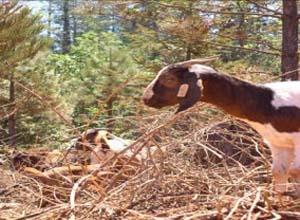Article Written by:
Glenn Nader, University of California Cooperative Extension, Yuba City, CA
Targeted grazing is the intentional use of livestock to modify vegetation by consumption to accomplish management goals. In terms of wildfire fuel reduction, targeted grazing is often used to reduce the amount, height and continuity of vegetation. For targeted grazing to be effective, it should be tied to fuel management objectives and tightly managed. Because targeted grazing focuses on modifying fuel characteristics and not animal production, it normally costs more than typical grazing programs. Grazing usually modifies fuels by ingesting or trampling smaller plant material that is less than ¼ inch in diameter. This size of fuel is very influential on fire behavior.
Targeted grazing is a dynamic fuel management tool with many plant and animal variables, and it requires sufficient knowledge of the critical control points of grazing to reach treatment objectives. Those control points involve the species of livestock being grazed (cattle, sheep, goats, or a combination); the animals’ previous grazing experience (which can affect their preferences for certain plants); the time of year (as it relates to plant nutrient content that will vary during the year); animal grazing concentration (intensity), grazing duration; plant palatability; plant toxic secondary compounds that can limit or prevent animals from grazing (i.e. tannins, terpenes, alkaloids); and animal age and nutrient needs.
The grazing approach to fuel treatment differs with whether the plant is an annual or perennial. With annuals (plants that grow from a seed each year), the treatment is to remove plants each year when the animals will ingest or trample them. Grazing before seed is produced can change amount of seeds that are available to germinate next year, and with long-term use and the proper timing, grazing can change the plants in the fuel treatment area. For perennials (plants that grow from the same roots each year), the management could be designed to reduce the amount fuel or eliminate plants. Repeated grazing that defoliates the plant depletes the root carbohydrates and can cause death of targeted species. Root carbohydrate reserves are at their lowest level just after the period when the plants start growing each year. If plants are severely grazed early in the growing season, carbohydrate reserves are depleted, and plant vigor is reduced. Removal of bark and repeated defoliation by grazing are two other ways to destroy the plant. A more sustainable use of grazing would be to annually graze fuel treatment areas following a mechanical treatment, such as mastication, or burning. This approach may provide sprouting and young vegetation that is higher in nutrition. This could maintain or improve animal performance while accomplishing fuel management objectives.
Goats have compounds in their saliva that allow them to consume a greater quantity of plants containing tannins compared to many other animals. Tannins are very damaging to the animal’s tissues and complicate digestion. Also, their smaller mouth size allows them to selective graze the plant and avoids thorns.
If the nutritional quality of the targeted plant is lower than the animal nutrient requirements or if it contains toxic secondary compounds, then grazing treatments can be expensive to implement and require the animal owner to provide supplemental feeds.
For more information on grazing go to https://targetedgrazing.org/other-resources/targeted-grazing/

